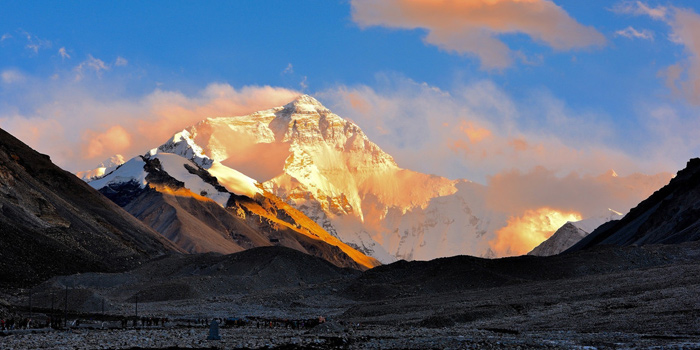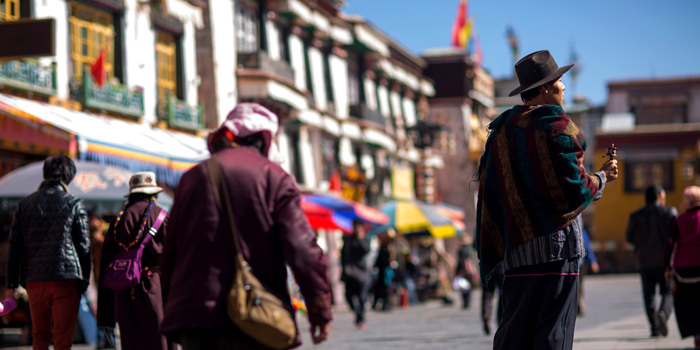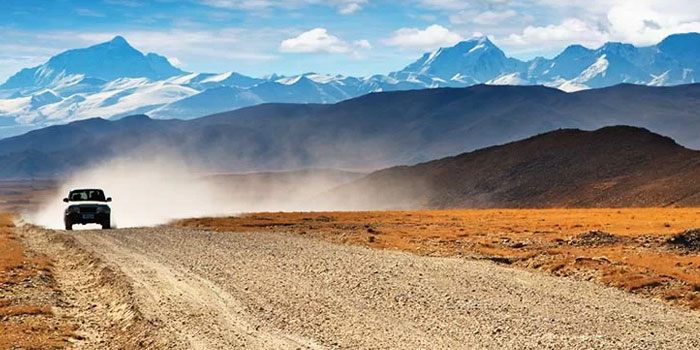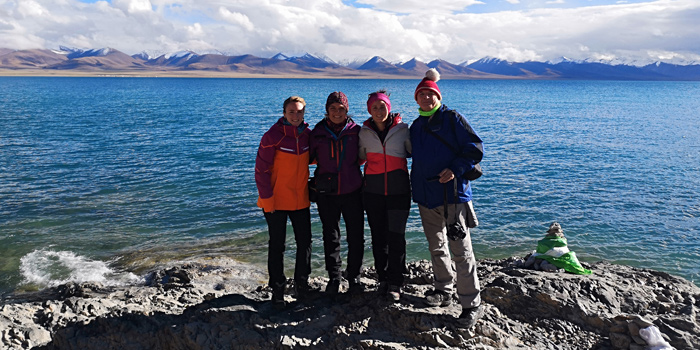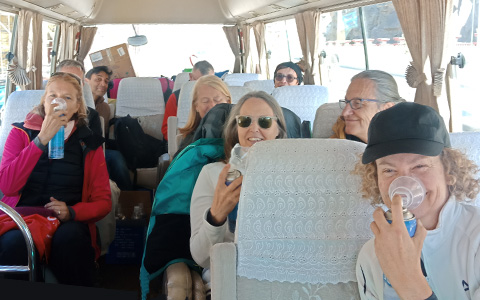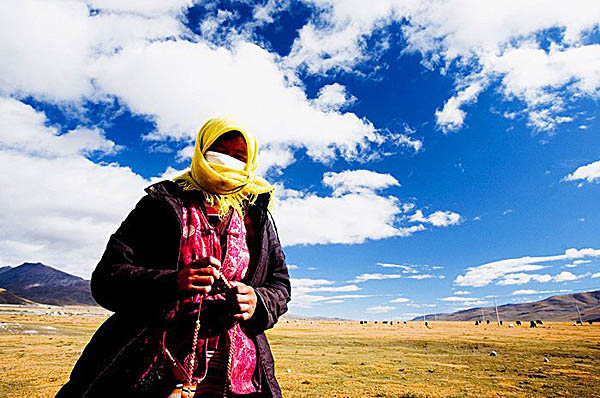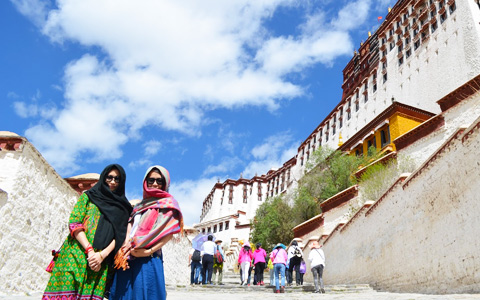How to Avoid Altitude Sickness in Tibet? 10 Things to Know for a Healthy Trip in Tibet
Traveling to Tibet sets it apart from almost every other destination on the planet, making it one of the world's most unique places to visit. Not only is this extraordinary destination unparalleled in its appeal, but it's also situated on the world's highest plateau, the Qinghai-Tibet Plateau in western China.
With an average altitude of around 4,000 meters (13,123 ft.), the Tibet Autonomous Region is one of the few places where even a simple trip, without any mountain climbing, can expose travelers to altitude sickness symptoms.
For regular tourists in Tibet, experiencing minor symptoms of altitude sickness is common in one way or another. Here, we provide a comprehensive guide to altitude sickness – how to manage it and even ways to avoid it if possible.
 1. Prepare Physically and Mentally before visiting Tibet
1. Prepare Physically and Mentally before visiting Tibet
 2. Prefer flight to Tibet instead of Tibet Train
2. Prefer flight to Tibet instead of Tibet Train
 3. Prepare Proper Medicine for AMS relief
3. Prepare Proper Medicine for AMS relief
 4. Don’t Catch a cold before departure to Tibet
4. Don’t Catch a cold before departure to Tibet
 5. Stay in Lhasa for a day or two to acclimate to high altitude
5. Stay in Lhasa for a day or two to acclimate to high altitude
 6. Get Enough Rest before Traveling
6. Get Enough Rest before Traveling
 7. Always follow the Gradual Ascent Rule
7. Always follow the Gradual Ascent Rule
 8. Keep Proper Dining during Your stay in Tibet
8. Keep Proper Dining during Your stay in Tibet
 9. Don’t Stay too Long at the Mountain Pass
9. Don’t Stay too Long at the Mountain Pass
 10. Get to a lower altitude place if you suffer from altitude sickness
10. Get to a lower altitude place if you suffer from altitude sickness
1. Prepare Physically and Mentally before visiting Tibet
Altitude sickness is the main health concern when traveling to Tibet. Many people feel different symptoms at high places, like headaches, feeling sick in the stomach, being dizzy, tiredness, trouble breathing, loss of appetite, problems sleeping, and feeling unsteady.
This happens because there's less oxygen at high places. When you visit Tibet, your lungs and blood have to work harder to give enough oxygen to your important body parts.
Doing some exercises before you go can help a bit, but remember, even if you're fit, you can still get altitude sickness. Being relaxed and happy will help you more during your Tibet tour.
Knowing that many people get altitude sickness and that the symptoms usually go away after your body gets used to the high place can make you feel better. Don't worry too much about it.
2. Prefer flight to Tibet instead of Tibet Train
The idea that taking trains to Tibet helps you adjust to the high altitudes in Tibet is actually a false belief that keeps getting repeated.
Since all Tibet trains are pumped with oxygen after passing Golmud, the air inside the train has more oxygen than what's usually at the same sea level.
Yes, it is not likely to get high altitude sickness on the train to Tibet. But if you experience altitude sickness on the train, things can actually get worse. Because the accommodations on the train are limited, if you can't get good rest, the symptoms might become even more severe.
Therefore, if you are travelling just for the relief of altitude sickness (and not for a glimpse of the beautiful scenery along the Qinghai-Tibet Railway), it is best to fly directly into Tibet. You can rest better at the hotel after arriving in Lhasa to allow your body to adapt to the high altitude of the area.

3. Prepare Proper Medicine for AMS relief
Medications, both chemical and natural, can alleviate or even prevent altitude sickness symptoms. The primary drugs to combat altitude sickness include Acetazolamide (Brand Name: Diamox) and Dexamethasone. Other drugs used to combat altitude sickness symptoms are ibuprofen or paracetamol for headaches and anti-nausea tablets for those feeling sick.
Traditional Chinese Medicine (TCM) offers lesser-known remedies like 'Hong Jing Tian.' Available in Chinese pharmacies, it's believed to reduce the risk of altitude sickness. Made from the root of the Rhodiola plant, this remedy is affordable and has been tested by travelers worldwide. While not guaranteed, it's worth trying before resorting to prescription drugs.
Remember to consult your doctor before taking any medications to ensure they're safe for you.
4. Don’t Catch a cold before departure to Tibet
Catching a cold before you travel to Tibet can reduce the body’s ability to properly acclimate to the higher altitude. This happens by lowering the number of red blood cells carrying oxygen around the body, redirecting them to aid in fighting the illness. If you have a cold or have recently recovered from one, you should wait at least two weeks after full recovery before traveling. This ensures your body is back to full strength.
5. Stay in Lhasa for a day or two to acclimate to high altitude
While altitude sickness can be severe, only a few tourists actually suffer greatly from it. Most people encounter some form of altitude sickness symptom when they arrive in Tibet. Fortunately, they usually adapt to high altitudes within a day or two in Lhasa.
To ensure a smoother experience on your Tibet tour, particularly if you plan to visit Everest Base Camp or Mount Kailash, it's recommended to spend a few days in Lhasa city at the start of your journey.
6. Get Enough Rest before Traveling
Once you arrive in Tibet, normally in Lhasa, you really need to rest properly to ensure that your body is ready for the days of acclimatizing ahead. Plenty of good rest can reduce the risk of altitude sickness as the body is at full strength and can adjust faster and more easily.
Avoid strenuous exercise, smoking, and taking additional oxygen if you can, to reduce the risk of altitude sickness. Every time you use oxygen to help relieve the symptoms, you reduce the body’s adjustment and it can sometimes have to start producing more red blood cells again from the start. Oxygen should only be used if absolutely necessary for life-threatening conditions.
 Have a rest while touring Potala Palace
Have a rest while touring Potala Palace
7. Always follow the Gradual Ascent Rule
The “gradual ascent” rule is an important rule when traveling at higher altitudes, especially if you are intending to travel even higher. When traveling at altitudes above 2,500-3,000 meters, it is recommended to ascend no more than 500 meters per day, and when ascending, to have regular rest days after every 1,000 meters.
When you arrive in Lhasa, you will have a few days of light sightseeing in the city before heading off into the vast open wilderness of the plateau. This time is best spent resting and acclimatizing when not touring the sights, to better ready yourself for higher altitudes, such as Gyantse, Shigatse, Lake Namtso, and the sacred Mount Kailash. It is also recommended to sleep at a lower altitude than the highest altitude you reached during the day.
8. Keep Proper Dining during Your stay in Tibet
Dining in Tibet can be tempting, but for at least the first couple of days you should try and avoid the delicious street foods of Lhasa, and stick to a more protein-rich diet. Plenty of red meat (including good solid yak meat!), vegetables, and other high protein foods such as local yogurt, are good for the digestion and replacing lost energy from the body’s adjustment to the higher altitude.
And try to avoid coffee and strong western-style tea, as these are both diuretics, and can leave you dehydrated and more susceptible to altitude sickness. You should also drink plenty of water to stay as hydrated as possible, as this helps with a faster adjustment to the altitude.
 You should drink plenty of water during your Tibet travel
You should drink plenty of water during your Tibet travel
9. Don’t Stay too Long at the Mountain Pass
If you are traveling to any of the most popular areas of Tibet outside Lhasa, such as Lake Namtso, Mount Everest, and Mount Kailash, you will be traveling over a long distance and ascending relatively high. You will also be traveling over three of the highest passes in the world, all of which lie at altitudes above 5,000 meters. These high passes can bring on bouts of altitude sickness if you spend too long at the crest, so after reaching the top, take the photos you need quickly, so that you can start to descend and remove the chance of altitude sickness.
10. Get to a lower altitude place if you suffer from altitude sickness
The occurrence of altitude sickness depends on the altitude. The higher altitude, the more serious symptoms appear. If you suffer from altitude sickness, the best remedy is to get to a lower altitude.
If you are feeling the effects of altitude sickness during the trip to Tibet, let your guide know immediately. Our expert Tibetan tour guides are all well-trained in recognizing and treating the symptoms of altitude sickness. And all our vehicles contain oxygen tanks for your use if necessary. Just let your guide know your situation and he/she will help you. Also, they can contact your personal trip advisor, who can help with any medical emergencies.
What to Do When You Have Altitude Sickness in Tibet?
If you are feeling the symptoms of altitude sickness, whether still in Lhasa or out on the road, then you should inform your guide and other party members, and seek help to alleviate the symptoms. Always carry the medicines you need and can take, and ask for oxygen if you feel you need it. If the symptoms persist or do get worse, then you should move to a location at least 1,000 meters lower immediately to ensure the symptoms do not get any more severe. Remember, severe altitude sickness can be potentially fatal.
Conclusion
Altitude sickness does not affect everyone traveling to Tibet, and you may be lucky to not have to experience the symptoms once you arrive in Lhasa. However, you should still be prepared for it and know what the symptoms are, how to recognize them, and how to treat them. Ignorance in terms of altitude sickness can cost you more than just the ruined holiday.

I am a tour guide in Tibet an was Born in Kham Tibet, I am the father of 2 little girls, bachelor's degree. I have more than 7-years experience of being a tour guide in Tibet. I am a warm, friendly, knowledgeable and attractive guy.
Related Articles & Posts
Most Popular Tibet Tour Packages
-

Lhasa - Gyantse - Shigatse - Everest Base Camp - Shigatse - Lhasa
USD939
View Details -

Lhasa - Gyantse - Shigatse - E.B.C - Saga - Kailash Trek - Darchen - Lake Manasarovar - Saga - Gyirong - Tingri - Lhasa
USD2059
View Details -

10 Days Lhasa to Everest Base Camp and Namtso Lake Small Group Tour
Lhasa - Gyantse - Shigatse - EBC - Shigatse - Lhasa - Namtso Lake - Damxung - Lhasa
USD1289
View Details -

8 Days Driving Across Himalaya Overland Adventure from Kathmandu to Lhasa
Kathmandu - Gyirong - Everest Base Camp - Tingri - Shigatse - Gyantse - Lhasa
USD1069
View Details -

4 Days Lhasa Impression Small Group Tour: Explore the Heart of Tibet and Mingle with the Locals
Lhasa
USD509
View Details -

Lhasa - Gyantse - Shigatse - Everest Base Camp - Gyirong - Kathmandu
USD979
View Details -

Lhasa - Gyantse - Shigatse- Lhasa
USD799
View Details -

13 Day Lhasa, Mt. Everest, Mt. Kailash, Lake Manasarovar and Kathmandu Adventure Tour
Lhasa - Gyantse - Shigatse - EBC - Saga - Darchen - Kailash Trek - Darchen - Saga - Gyirong - Kathmandu
USD2059
View Details


.jpg)



